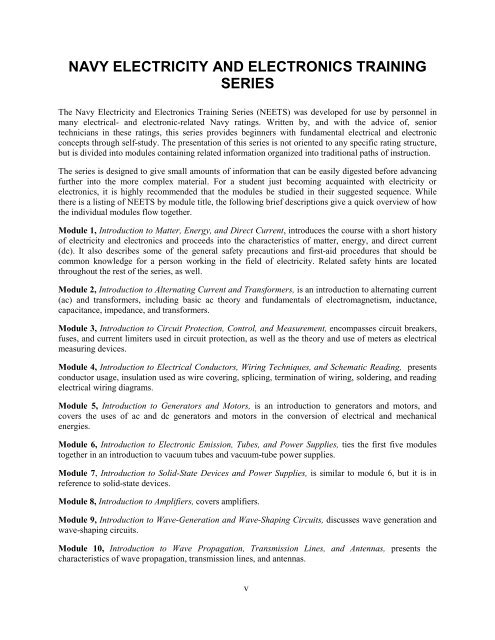Navy Electricity and Electronics Training Series - Historic Naval ...
Navy Electricity and Electronics Training Series - Historic Naval ...
Navy Electricity and Electronics Training Series - Historic Naval ...
Create successful ePaper yourself
Turn your PDF publications into a flip-book with our unique Google optimized e-Paper software.
NAVY ELECTRICITY AND ELECTRONICS TRAININGSERIESThe <strong>Navy</strong> <strong>Electricity</strong> <strong>and</strong> <strong>Electronics</strong> <strong>Training</strong> <strong>Series</strong> (NEETS) was developed for use by personnel inmany electrical- <strong>and</strong> electronic-related <strong>Navy</strong> ratings. Written by, <strong>and</strong> with the advice of, seniortechnicians in these ratings, this series provides beginners with fundamental electrical <strong>and</strong> electronicconcepts through self-study. The presentation of this series is not oriented to any specific rating structure,but is divided into modules containing related information organized into traditional paths of instruction.The series is designed to give small amounts of information that can be easily digested before advancingfurther into the more complex material. For a student just becoming acquainted with electricity orelectronics, it is highly recommended that the modules be studied in their suggested sequence. Whilethere is a listing of NEETS by module title, the following brief descriptions give a quick overview of howthe individual modules flow together.Module 1, Introduction to Matter, Energy, <strong>and</strong> Direct Current, introduces the course with a short historyof electricity <strong>and</strong> electronics <strong>and</strong> proceeds into the characteristics of matter, energy, <strong>and</strong> direct current(dc). It also describes some of the general safety precautions <strong>and</strong> first-aid procedures that should becommon knowledge for a person working in the field of electricity. Related safety hints are locatedthroughout the rest of the series, as well.Module 2, Introduction to Alternating Current <strong>and</strong> Transformers, is an introduction to alternating current(ac) <strong>and</strong> transformers, including basic ac theory <strong>and</strong> fundamentals of electromagnetism, inductance,capacitance, impedance, <strong>and</strong> transformers.Module 3, Introduction to Circuit Protection, Control, <strong>and</strong> Measurement, encompasses circuit breakers,fuses, <strong>and</strong> current limiters used in circuit protection, as well as the theory <strong>and</strong> use of meters as electricalmeasuring devices.Module 4, Introduction to Electrical Conductors, Wiring Techniques, <strong>and</strong> Schematic Reading, presentsconductor usage, insulation used as wire covering, splicing, termination of wiring, soldering, <strong>and</strong> readingelectrical wiring diagrams.Module 5, Introduction to Generators <strong>and</strong> Motors, is an introduction to generators <strong>and</strong> motors, <strong>and</strong>covers the uses of ac <strong>and</strong> dc generators <strong>and</strong> motors in the conversion of electrical <strong>and</strong> mechanicalenergies.Module 6, Introduction to Electronic Emission, Tubes, <strong>and</strong> Power Supplies, ties the first five modulestogether in an introduction to vacuum tubes <strong>and</strong> vacuum-tube power supplies.Module 7, Introduction to Solid-State Devices <strong>and</strong> Power Supplies, is similar to module 6, but it is inreference to solid-state devices.Module 8, Introduction to Amplifiers, covers amplifiers.Module 9, Introduction to Wave-Generation <strong>and</strong> Wave-Shaping Circuits, discusses wave generation <strong>and</strong>wave-shaping circuits.Module 10, Introduction to Wave Propagation, Transmission Lines, <strong>and</strong> Antennas, presents thecharacteristics of wave propagation, transmission lines, <strong>and</strong> antennas.v

















